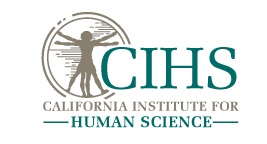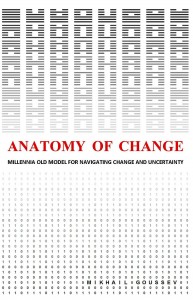Google Books | Google Play | Amazon | YouTube
“Everything in the universe, from human relationships to high energy particle interactions is participating in a ceaseless process of change guided by simple, yet universal patterns. From the beginning of philosophical thought in ancient China, nearly 4000 years ago through current research in physics and molecular biology, one basic question is being posed: How do phenomena change?” (Phillips, 1992)
The book Anatomy of Change: Millennia Old Model For Navigating Change and Uncertainty by Mikhail Goussev explores one of the world oldest and perhaps the most universal system developed by mankind – the I Ching, or the ancient Chinese Classic of Change – to address this question in the context of human relationships and organizational dynamics.
Endorsements:
 Mikhail’s dissertation, which served as a foundation for this book, pursued the bold goal of establishing parallels between the ancient Taoist philosophy and worldview and the present economic model of the Western world based on the universal principals of Yin and Yang. This book addresses some of the critical feedback I had provided and makes this theory applicable and stimulating to individuals in the fields of business and economics. I hope many people will use Mikhail’s book to gain insights that are relevant to their present and future professional activities.
Hiroshi Motoyama, Ph.D., Ph.D. President of CIHS
The book Anatomy of Change by Mikhail Goussev is the most up-to-date explanation of the ancient Chinese classic, the I Ching, teaching humanity how to adapt to inevitable changes while keeping the constancy of our human-heartedness. There is no other research in China or in the West that makes the sophisticated patterns of change described in the I Ching so easy to understand and apply to our daily activities in business world, and personal and professional relationships. It is a must-read book for everyone who wishes to understand the wisdom of the Chinese civilization and why this longest-lived society in human history is able to develop faster than that of any other younger nation.
Tanya Storch, Ph.D. Professor of Buddhist Studies, University of the Pacific
Mikhail’s dissertation, which served as a foundation for this book, pursued the bold goal of establishing parallels between the ancient Taoist philosophy and worldview and the present economic model of the Western world based on the universal principals of Yin and Yang. This book addresses some of the critical feedback I had provided and makes this theory applicable and stimulating to individuals in the fields of business and economics. I hope many people will use Mikhail’s book to gain insights that are relevant to their present and future professional activities.
Hiroshi Motoyama, Ph.D., Ph.D. President of CIHS
The book Anatomy of Change by Mikhail Goussev is the most up-to-date explanation of the ancient Chinese classic, the I Ching, teaching humanity how to adapt to inevitable changes while keeping the constancy of our human-heartedness. There is no other research in China or in the West that makes the sophisticated patterns of change described in the I Ching so easy to understand and apply to our daily activities in business world, and personal and professional relationships. It is a must-read book for everyone who wishes to understand the wisdom of the Chinese civilization and why this longest-lived society in human history is able to develop faster than that of any other younger nation.
Tanya Storch, Ph.D. Professor of Buddhist Studies, University of the Pacific
In our drive to discover new tools for better understand and managing change, we short-sightedly overlook older tools long available to those willing to understand them. In The Anatomy of Change, Michael Goussev calls forth the millennia old empirical observations of China captured in the Classic of Change (The I Ching). He shows that seeking to understand how the 64 recurring patterns of change documented in this text can help us better grasp the forces influencing our day-to-day lives, personally and professionally. His book gives us tools to reflect powerfully on how to more thoughtfully navigate the change and uncertainty we all face at key points in our lives and careers.
Kaihan Krippendorff, Author of “Outthink the Competition”, www.kaihan.netBibliography
Brandenburger, A. M., & Nalebuff, B. J. (1997). Co-Opetition. New York: Currency Doubleday.
Campbell, J. (1991). Reflections on the Art of Living. A Joseph Campbell Companion. New York: HarperPerennial.
Chang, S. T. (1985). The Great Tao. Reno: Tao Publishing.
Cleary, T. (1986). The Taoist I Ching. Boston & London: Shambhala Publications Inc.
Cleary, T. (1989). I Ching Mandalas. A Program of Study for The Book of Changes. Boston: Shambhala Publications Inc.
Gardner, M. (1974). Mathematical Games: The Combinatorial Basis of The I Ching, the Chinese Book of Divination and Wisdom. Scientific American, 109-13.
Gelman, E. (2008). Fear of a Black Swan: Fear of a Black Swan: Why Wall Street Failed to Anticipate Disaster. Money, 60-61.
Ghamari-Tabrizi, S. (2005). The Worlds of Herman Kahn: The Intuitive Science of Thermonuclear War. Cambridge: Harvard University Press.
Goussev, M. (2006). Stimulating Intuition And Creativity In Business Analysis And Decision Making With The I Ching. Dissertation. San Diego: California Institute for Human Science.
Green, R. (2003). The I Ching Workbook. A Step-by-Step Guide to Learning the Wisdom of the Oracles. . San Diego: Thunder Bay Press.
Javary, C. (1997). Understanding the I Ching. A complete guide to the history and use of the ancient Chinese oracle. . Boston & London: Shambhala Publications Inc.
Jung, C., & Hull, R. F. (1973). Synchronicity. An Acausal Connecting Principle. . Princeton: Princeton University Press.
Karcher, S. (2002). I Ching. The classic Chinese Oracle of Change. The First Complete Translation with Concordance. London: Vega.
Kleiner, A. (1999). Doing Scenarios. Whole Earth, 77-81.
Kleiner, A. (2003). The Man Who Saw the Future. Strategy + Business, 26-31.
Krippendorff, K. (2003). The Art of the Advantage. 36 Strategies to Seize The Competitive Edge. New York: Texere.
Lao-tzu. (1991). Tao Te Ching. (S. Mitchell, Trans.) New York: HarperPerennial.
McNeilly, M. (1996). Sun Tzu and the Art of Business. New York: Oxford University Press.
Mihm, S. (2008). Dr. Doom. The New York Times Magazine, 26.
Mintzberg, H. (1976). Planning on the Left Side and Managing on the Right. Harvard Business Review.
Newman, J. R. (1961). Review of ‘On Thermonuclear War’ by Herman Kahn. Scientific American 204.3, 197.
Phillips, K. L. (1992). The Riddle of Change. In G. N. Epstein, Studies in Non-Deterministic Psychology. New York: Human Sciences Press Inc.
Porter, M. E. (1980). Competitive Strategy. New York: Free Press.
Schwartz, P. (1996). The Art of the Long View: Planning for the Future in an Uncertain World. New York: Doubleday.
Teck, F. C., & Grinyer, P. H. (2000). Organizing Strategy. Sun Tzu Business Warcraft. Singapore: Horizon Books Pte Ltd.
Wack, P. (1985). Scenarios: The Uncharted Waters Ahead. Harvard Business Review, 73-89.
Walker, B. B. (1992). The I Ching or Book of Changes. A guide to Life’s Turning Points. New York: St. Martin’s Griffin.
Walter, K. (1996). Tao of Chaos. DNA & The I Ching. Unlocking the Code of the Universe. . Rockport, MA: Element Books, Inc.
Wilhelm, R. (1962). The Secret of the Golden Flower. A Chinese Book of Life. New York: A Harvest/HBJ Book.
Wilhelm, R., & Baynes, C. F. (1950). The I Ching or Book of Changes. Princeton: Princeton University Press.
Yi, C. (1995). The Tao of Organization. The I Ching for Group Dynamics. (T. Cleary, Trans.) Boston: Shambhala Publications, Inc.
